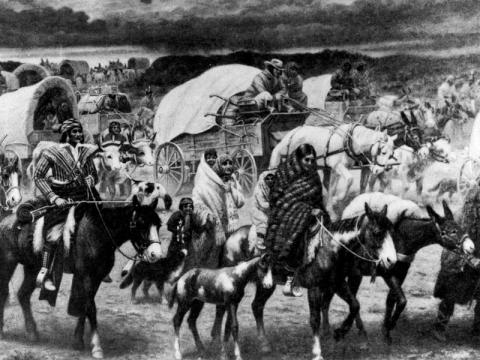 Crowd of people on horses, in covered wagons, and on foot move across a dirt path under dark clouds." width="" />
Crowd of people on horses, in covered wagons, and on foot move across a dirt path under dark clouds." width="" /> Crowd of people on horses, in covered wagons, and on foot move across a dirt path under dark clouds." width="" />
Crowd of people on horses, in covered wagons, and on foot move across a dirt path under dark clouds." width="" />
Subject: Literacy and Language Arts,Social Studies Lesson Duration: 90 Minutes Common Core Standards: 9-10.RI.8, 9-10.RI.9, 11-12.RI.1, 11-12.RI.6, 11-12.RI.7, 11-12.RI.8, 11-12.RI.9, 11-12.SL.1.a, 11-12.SL.1.b, 11-12.WHST.8, 11-12.WHST.9 State Standards: Georgia U.S. History: SSUSH7(a) Additional Standards: Georgia Reading & Writing Standards for Literacy in History/Social Studies (RHSS) Grade 11-12: L11-12RHSS #1, 2, 6, 9 and L11-12WHST #8. Thinking Skills: Remembering: Recalling or recognizing information ideas, and principles. Understanding: Understand the main idea of material heard, viewed, or read. Interpret or summarize the ideas in own words. Analyzing: Break down a concept or idea into parts and show the relationships among the parts. Evaluating: Make informed judgements about the value of ideas or materials. Use standards and criteria to support opinions and views.
a. How does studying locations and primary documents aid in our research of actual events?
b. What were the reasons behind the support and opposition of the Indian Removal Act of 1830?
a. Students will analyze a variety of primary and secondary sources to explain the actions of President Jackson and Congress in the establishing the Indian Removal Act of 1830.
b. Students will analyze a variety of primary and secondary sources to explain the positions of the Cherokee regarding removal, as well as those who supported the Cherokee in their resistance to removal.
The Trail of Tears was the result of many decades of struggle for the Cherokee Nation and other American Indian tribes. Since the early 1800s, the Cherokee Nation tried to protect their lands by assimilating into the European-American culture as much as possible. However, when Andrew Jackson became president in 1828, that tactic rapidly changed. The Dahlonega Gold Rush pushed many miners onto Cherokee land in northern Georgia. The miners wanted the land for mining towns and seeking their fortune. The Indian Removal Act of 1830 gave President Jackson the power to negotiate treaties to remove the Cherokees from their land. Despite the Cherokees not signing these treaties, lotteries were held to distribute Cherokee land to European-Americans.
John Ross and his Cherokee Nation resisted through American legal channels by taking their case to the Supreme Court. In the 1831 case Cherokee Nation v Georgia, Chief Justice John Marshall ruled the federal judiciary could not intervene. However, the Cherokee Nation won a victory in 1832 with Worcester v Georgia. Marshall ruled that Georgia could not enforce state laws on the sovereign Cherokee Nation within their lands. Despite this, President Jackson ‘negotiated’ the New Treaty of Echota in 1835.
This treaty was signed by Major Ridge and members of the Cherokee Nation who were not authorized to sign on their behalf.This treaty led to the U.S. government’s forced and coerced removal of 100,000 American Indians from their homelands to distant reservations in 1837. This included members of the Cherokee, Choctaw, Chickasaw, Creek, and Seminole Nations. They traveled many different paths, but they share this story. Today, the Trail of Tears is the cultural and physical landscape that tells that story.
Read through the activities to determine which one(s) most appropriately match with your students and teaching goals. Prepare enough materials from each corresponding activity for your students.
This lesson plan is adapted from a lesson plan from the NPS affilitate Teaching with Historic Places. Read through their lesson, Discover the Trail of Tears: A Lightning Lesson from Teaching with Historic Places. Their lesson covers 5th - 12th grade standards, thus provides more choices for expanding your students' knowledge on this topic.
Explain to the students we will study Andrew Jackson's Indian Removal Act of 1830. Ask students what historic places we might visit to help us learn about this law and its consequences. After a few minutes, instruct students to work with a partner to explore sample sites along the Trail of Tears. Partners need to discuss how each site may help them study the impacts of the Indian Removal Act. After about 10 minutes, ask for student volunteers to share what they discussed.
enacted - to put into practice
bill - a draft of a proposed law presented for discussion
act - a written ordiance by Congress
extinguish - to put an end to; annihilate
benevolent - well meaning and kindly
consummation - the point at which something is complete or finalized
aborigines - a person who has been in a country from the earliest of times
vexations - something that causes annoyance, frustration, or worry
philanthropy - the desire to promote the welfare of others
This assessment instructs students to choose 5 quotes or concepts from lessons learned and write their reactions or reflections to each.
High School Reflective Reading Assessment
Primary documents can be difficult to work through with their seemingly archaic language. In activity 3, the article opposed to the Indian Removal Act is a little easier to read than President's Jackson's article. Plan accordingly. Other ideas are:
Encourage students to read more primary documents about the debates which occured in Congress over the Indian Removal Act. What were some of the reasons for and against voting for this bill?